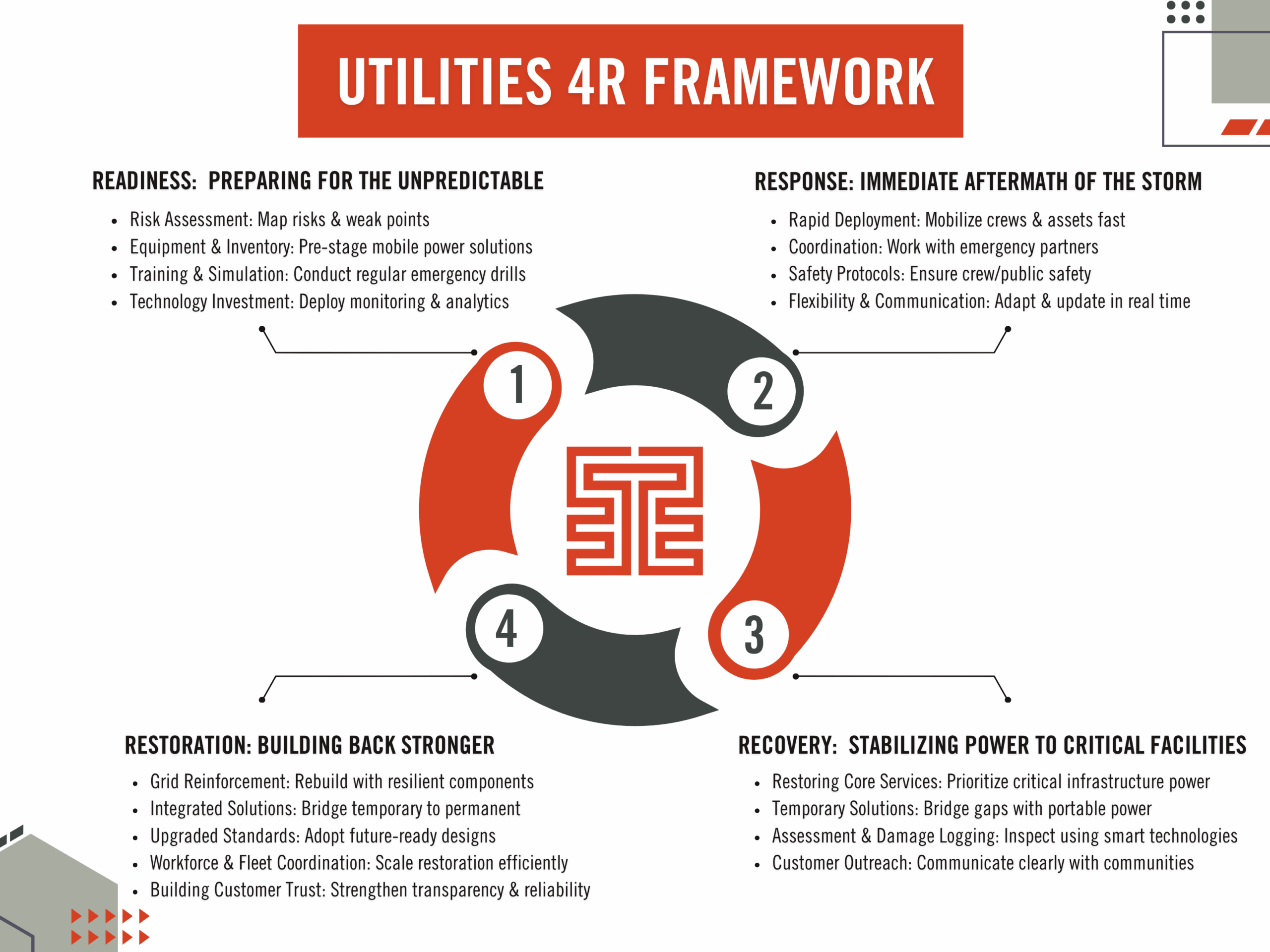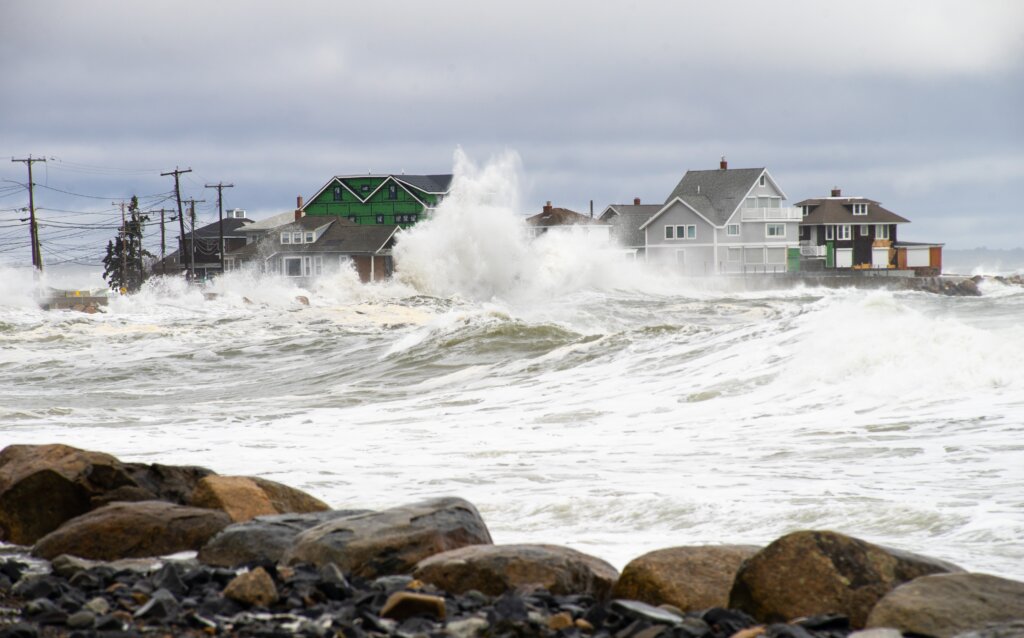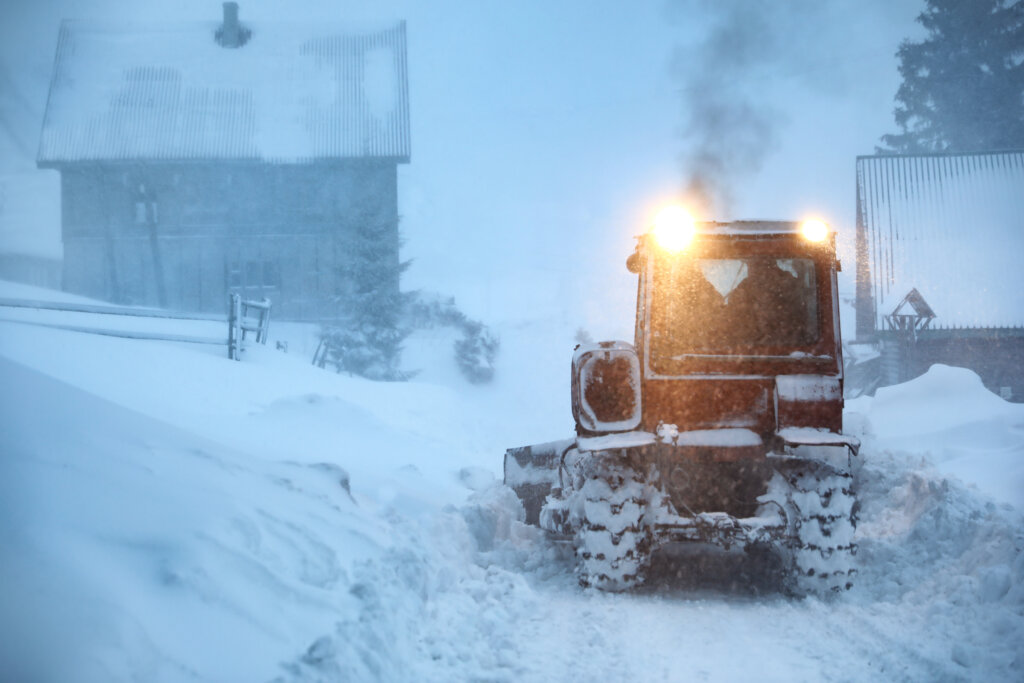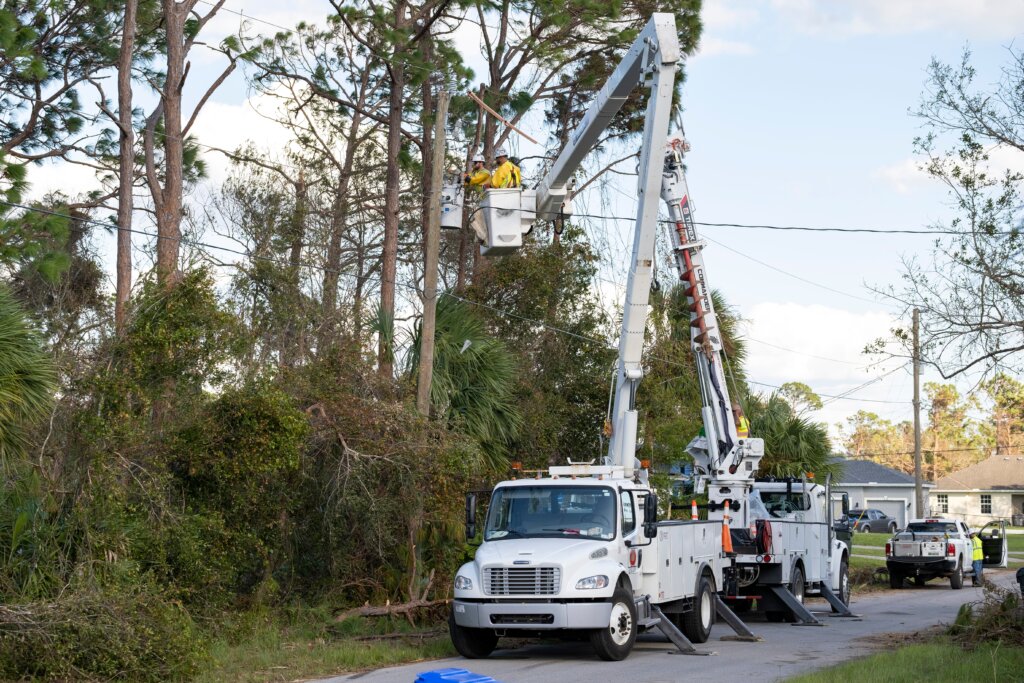In just 5 short years (since 2020), United States electric utilities have shouldered an astonishing $12 billion in costs … not for rebuilding communities or repairing homes, but solely for rebuilding the power grid after Category 4 or 5 hurricanes.1 That number speaks volumes about the escalating toll of natural disasters on our electrical infrastructure. But that reflects only part of the story … by the utilities address “restoration”, they are already working to catch-up.
In other words, the real story … the smarter, forward-thinking picture … starts much earlier, and ends much later. That story is about how utilities plan, react, rebuild, and evolve through a systematic and integrated approach that can be easily remembered by considering the “4 R’s”: Readiness, Response, Recovery, and Restoration.
These 4 phases aren’t simply a checklist … they’re a continuous, overlapping cycle of resilience:
- Readiness how well utilities can anticipate and prepare for threats.
- Response measures the utilities’ ability to act quickly and decisively when natural disasters strike.
- Recovery ensures that systems and people can bounce back … not just to the status quo, but stronger.
- Restoration still matters … bringing electrical power back online is critical … but it’s only one part of a broader, more strategic lifecycle.
This article explores how the “4 R’s” guide today’s utilities through increasingly severe and frequent weather events. Each phase reinforces the other phases … lessons learned become tools for the future. Additionally, this article illustrates why “customer trust”, operational agility, and long-term resilience hinge on embracing the full spectrum of natural disaster readiness and response. In an era of stronger storms and rising scrutiny, the utilities that thrive won’t be the ones who restore the fastest … they will be the ones who prepare the smartest.

Readiness: Preparing For The Unpredictable
For electrical utilities, uncertainty is a given. Natural disasters such as hurricanes, tornadoes, high winds, wildfires, floods, and ice storms occur annually … yet the full accuracy of such severe weather forecasts are often unknown until only 2 – 3 days in advance. Therefore, the utilities’ ability to maintain power and public safety hinges on what to do before disaster strikes.
Risk Assessment
Risk assessment helps utilities strengthen their systems against natural disasters by evaluating both geographic and infrastructure vulnerabilities. This means mapping out areas prone to floods, wildfires, hurricanes, tornadoes, or ice storms … as well as thoroughly inspecting assets like substations, transmission lines, poles, transformers, and cables. Identifying risks and weak points in the infrastructure (e.g., wooden poles in hurricane zones or aging equipment in flood-prone areas) allows utilities to prioritize upgrades and better prepare for severe weather.
Equipment And Inventory
To prepare for natural disasters, utilities use risk assessments and outage data to strategically pre-position mobile substations, generators, and portable power equipment near high-risk areas, especially where critical infrastructure is located. The utilities also partner with fleet rental companies, which quickly order and stage portable power equipment (e.g., generators, load banks, cables, and distribution panels) from , from “Quick Ship” warehouses strategically located throughout the continental United States … thus ensuring these resources are ready and accessible when severe weather strikes.

Technology Investment
Technology investment is a cornerstone of modern utility resilience, particularly in the face of unpredictable natural disasters. Utilities can leverage advanced technology to maintain power and public safety.
Grid and station monitoring technologies (e.g., sequence of event recorders, sensors and smart meters) acquire real-time data on system performance and quickly spot problems during storms. Asset tracking with RFID, GPS, and IoT sensors helps utilities know where critical equipment and crews are, so that the utility can respond faster and use these resources efficiently. Predictive analytics combine outage history, weather forecasts, and live grid data to help utilities anticipate failures, stage resources, and prepare crews, improving their ability to respond to disasters even when timing is uncertain.
Response: Action In The Aftermath Of The Storm
Immediately after a storm-related power outage occurs, utilities focus on rapid assessments and actions to minimize disruption and ensure public safety. During this stage and as soon as it is safe to do so, utilities mobilize crews, deploy equipment, and coordinate with emergency services to address hazards, clear roads/highways, prioritize repairs, and restore critical infrastructure. Effective response relies on clear communication, real-time data, and efficient resource allocation to stabilize the situation and lay the groundwork for full recovery.

Advanced dispatch systems and real-time communication platforms enable utilities to quickly assign repair teams to affected areas … often using GPS and outage management systems to optimize routing and minimize response times. Utilities coordinate closely with facility managers and emergency responders to identify urgent needs and allocate resources where they will have the greatest impact. Coordination with first responders and local agencies is essential for clearing roads and highways, ensuring that utility crews can safely access damaged sites. Utilities may deploy specialized vehicles equipped with tools for debris removal and use drones or remote sensing technologies to assess hazards before crews arrive.
Throughout this process, strict safety procedures are enforced to protect first responders, utility crews and customers, and the public in general … including ‘live’ power line safety practices, hazard identification, and continuous communication with emergency services. This integrated, technology-driven approach ensures that utilities can swiftly address immediate threats, restore critical infrastructure, and maintain public safety during the initial hours following a natural disaster and a major power outage.
Recovery: Stabilizing The Grid And Powering Critical Facilities
During Recovery, utilities focus on stabilizing the grid and prioritizing temporary power solutions to critical facilities such as hospitals, emergency shelters, water and wastewater treatment plants, and grocery stores … before addressing commercial/residential customers.
While permanent electrical infrastructure repairs may be either underway or not yet possible, temporary portable power solutions (e.g., cable carts, cable, mobile generators, substations, power distribution equipment, and mobile solar-powered microgrids) are rapidly deployed to these essential locations to ensure public health, safety, and access to sanitation and vital services.
Transparent and timely communication with both the critical facilities and commercial/residential customers is also crucial during recovery; utilities provide regular updates on outage status, estimated restoration times, and the overall recovery strategy. This openness helps manage expectations, build and regain trust, and keep communities informed as both temporary and permanent power are systematically restored … eventually with the electrical grid returning to full strength.
Restoration: Building Back Stronger
Restoration marks the final stage of utility power restoration, focusing on returning the grid to full operational capacity and ensuring long-term reliability for all customers. After immediate threats have been addressed and critical facilities are stabilized, utilities turn their attention to comprehensive repairs, system upgrades, and the full restoration of service across their networks.
During power restoration efforts, utilities reinforce the grid by repairing or replacing damaged infrastructure (e.g., poles, power lines, and transformers), upgrading components to meet higher resilience standards, and reconfiguring grid networks for load balancing. This effort may include installing stronger poles, outage management systems (OMS), geographic information systems (GIS) … as well as smart grid sensors which enhance restoration speed/accuracy and improve system flexibility and fault detection. Utilities can also install reclosers, which minimize the duration and impact of outages caused by transient faults caused by future lightning strikes or fallen tree branches. By automatically restoring service after brief disturbances, reclosers improve grid reliability … thus reducing the need for manual repairs, and enabling utilities to maintain consistent power delivery to customers. Integrated electrical power solutions, such as distributed energy resources and microgrids, are increasingly used to enhance grid stability and provide backup power during future disruptions.

To scale and expedite restoration efforts, utilities mobilize extra repair crews from within their organization and also rely upon mutual aid agreements with utilities and electrical contracting firms from neighboring states … bringing in skilled workers and specialized equipment. Advanced asset management systems track the location and status of crews, equipment, and materials in real time … enabling utility crews to respond more quickly to widespread damage, accelerate repairs, and restore permanent grid power to all customers as swiftly and safely as possible.
Regaining customer trust is a critical outcome of the Restoration phase. Utilities achieve this through transparent communication about restoration progress, infrastructure improvements, and future preparedness measures. By openly sharing timelines, challenges, and successes, utilities foster stronger relationships with their communities and demonstrate a commitment to delivering reliable, resilient power in the face of evolving threats.
Conclusion
In the face of increasingly frequent and severe natural disasters, utility power restoration demands a proactive and systematic approach. The “4 R’s” detailed in this article — Readiness, Response, Recovery, and Restoration — provide a proven framework for utilities to anticipate challenges, act swiftly during crises, stabilize critical infrastructure, and ultimately rebuild stronger, more resilient grids. By investing in risk assessment, technology, equipment management, and transparent communication, utilities can minimize disruption, protect public safety, and restore essential services more efficiently.
Trystar partners with utilities, fleet rental customers, and electrical distributors to strengthen the power restoration process and embrace innovative solutions. Contact our team to begin these conversations!
____________________________
References:
1 Statistics in publicly available data from Entergy, Duke Energy, Florida Power & Light; as well as weather and energy news sources including Weather.com, ClaimsJournal.com, and FLPublicPower.com.